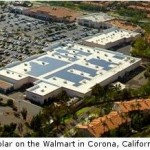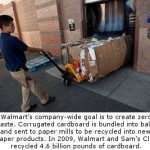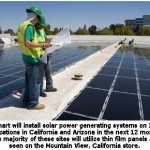
The new $115 million project of Wal-Mart Canada Corp., expected to open this fall, is to include high-efficiency LED lights; a white roof membrane designed to deflect 85 percent of sunlight heat; and pilot projects to test fuel-cell technology, solar thermal panels and a 225-kilowatt wind turbine to generate electricity for the center.
Rooftop solar systems and wind turbines also are planned for two Ontario projects that the company says it will disclose this spring.
“We’ve said we’re determined to build the greenest stores on the block and we’re taking further steps every day towards this goal,” Ken Farrell, Vice President of Store Development for Wal-Mart Canada, said in a statement announcing the initiatives.
Andy Ellis, Senior Vice President of the Supply Chain for Wal-Mart Canada, said the distribution center near Calgary would become “a living lab that demonstrates sustainable operations, products and technologies, while showing that environmental sustainability can go hand-in-hand with business sustainability.” Wal-Mart revealed the projects and other environmental initiatives at a conference it hosted in Vancouver, British Columbia. The conference attracted more than 300 business, government and non-profit executives and included many of Wal-Mart’s suppliers.
On Thursday, Wal-Mart executives at the company’s headquarters in Bentonville outlined plans to push its environmental efforts back through its global chain of suppliers. Production of the goods sold in its stores account for about 90 percent of the company’s overall environmental impact, Wal-Mart said.
With headquarters in Mississauga, Ontario, Wal-Mart Canada operates supercenters and discount outlets across the nation. Last week, the parent company said it intends to open 35 to 40 supercenters in Canada this year, more than half of them new or relocated stores and the others on-site renovations.
The projects will bring the total number of Wal-Mart stores in Canada to 325, of which 124 will be supercenters.
“For a market the size of Canada, that’s big,” said Doug Stephens, who runs Retail Prophet Consulting in Toronto.
Ron Lemaire, Vice President for Market Development at the Canada Green Building Council, said mainstream marketers are taking on more social responsibility for the performance of their facilities. “We’re seeing more and more interest from national and regional retailers,” he said.
The council develops best practices and guidelines for design and construction that lessen damage to the environment.
In most cases, Lemaire said, businesses that implement a “green-up” strategy, including a performance audit to identify potential savings, benefit financially from environmentally friendly building practices.

Stephens said that sustainability “is something you can promote, something that consumers like to see.” Still, he said, “I wouldn’t view that move by Wal-Mart in Canada as something that is characteristic in retail.” The major players talk a lot about sustainability, he said, but smaller operators have yet to embrace the push.
At the new distribution center, Wal-Mart Canada said, it will test the use of hydrogen fuel cells to replace lead-acid batteries in the material-handling fleet.
The company said it also intends to develop a sustainable-product index that will help customers measure the environmental impact of the goods they are buying, from production through disposal.
In July, Wal-Mart outlined a similar, multi-year plan to develop a product scorecard. Company executives said they hoped the sustainability index would move its suppliers and retail competitors toward business practices that have less impact on the environment and, in the process, cut costs.
However, in a briefing last week on environmental initiatives, Matt Kistler, Senior Vice President of Sustainability, said an environmental label for products is still at least five years away.
Source: Press Release from Arkansas Democrat-Gazette (Little Rock) dated February 28, 2010. Written by Steve Painter.








